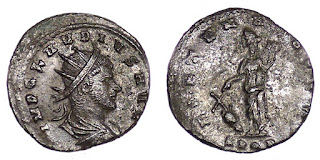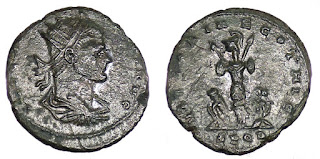The latter
half of the third century saw the number of Roman mints beginning to expand,
and, at the same time, the number of mints striking the civic coins go into
rapid decline. The new mints are usually not named on the coins and we need to
use find spots and style to propose mint locations.
It is
against this background that we see a series of coins beginning late in the
reign of Gallienus and continuing into Claudius II marked with SPQR on the
reverse.
RIC is of
little help here in that it gives them to “Asia” under Gallienus, perhaps
Antioch as pellets on the obverse are sometimes seen under the bust on the
obverse, similar to the Antioch coinage of Trebonianus Gallus. For Claudius II
it places them at Cyzicus, recognising that the later coins marked MC are
stylistically similar.
In 1975 a
paper in the British journal, Numismatic Chronicle, recognised that the SPQR
series under Gallienus may be Cyzicus, but the author suggested that all the
Asian sole reign coins of Gallienus were from the same location, eliminating
Antioch as a mint from the time.
Gysen proposed
an arrangement that agreed that the SPQR coins were ultimately produced at Cyzicus,
but the original location was Smyrna (CENB 1999). The change in location was proposed
to have taken place early in the reign of Claudius, recognised in the coinage by a first emission of unmarked coins, the
adoption of the MC mark for the second before reverting back to SPQR for the third and dropping all marks again for the fourth and final emission.
Huvelin supported
the idea that Smyrna may have been the original locus of the mint. This was based
partially on stylistic criteria, but also on the commonality of a reverse device,
an Amazon holding a bipenis, that occurred on both the civic issues from the city
and an antoninianus type of Gallienus.
Gysen’s arrangement
is not ideal, given the transition of marks, SPQR to MC to SPQR to nothing. It is
not the organisation adopted by the BnF for the cataloguing work in preparation
of the RIC revision. The SPQR coins attributed to Smyrna seem to be limited to the first emission through to early 269. After this date the establishment ceases and production transferred to
Cyzicus and there is a mixture of SPQR, MC and unmarked coins, depending on the emission.
GALLIENUS
Emission 1 ABVNDANTIA AVG (MIR 1524c) Smyrna
Emission 1 AEQVITAS AVG (MIR 1525c) Smyrna
Emission 1 CONSERVATOR AVG (MIR 1529c) Smyrna
Emission 1 VENER VICTRIX (MIR 1537c) Smyrna
Emission 2 P M TR P XVII (MIR 1540b) Smyrna
Emission 2 SALVS AVG (MIR 1547c) Smyrna
Emission ? PAX FVNDATA (unpublished) Smyrna
Emission ? VIRTVTI AVG (MIR -, RIC 676) SmyrnaCLAUDIUS II
Emission 1 VIRTVTI AVG (RIC 253, RIC temp 847) Smyrna, end 268- early 269
Emission 3 FORTVNA REDVX (RIC 238, RIC temp 953) Cyzicus, end 269 - early 270
Emission 3 PAX AETERNA (RIC 234, RIC temp 951) Cyzicus, end 269 - early 270
Elks, K; 'The eastern mints Valerian and Gallienus: the evidence of two new hoards from western Turkey' NC 7th ser, XV (1975), pp91-109
Gysen, P; 'A propos des ateliers de Smyrne et de Cyzique que sous Claude II le Gothique' CENB 36, no. 2 (1999), pp29-41














